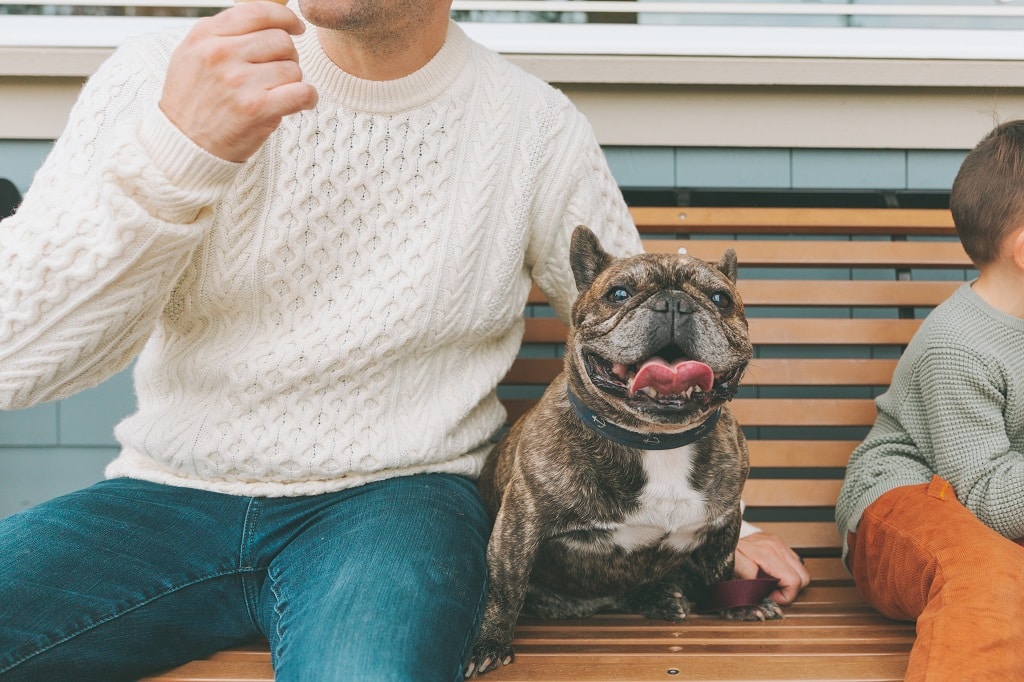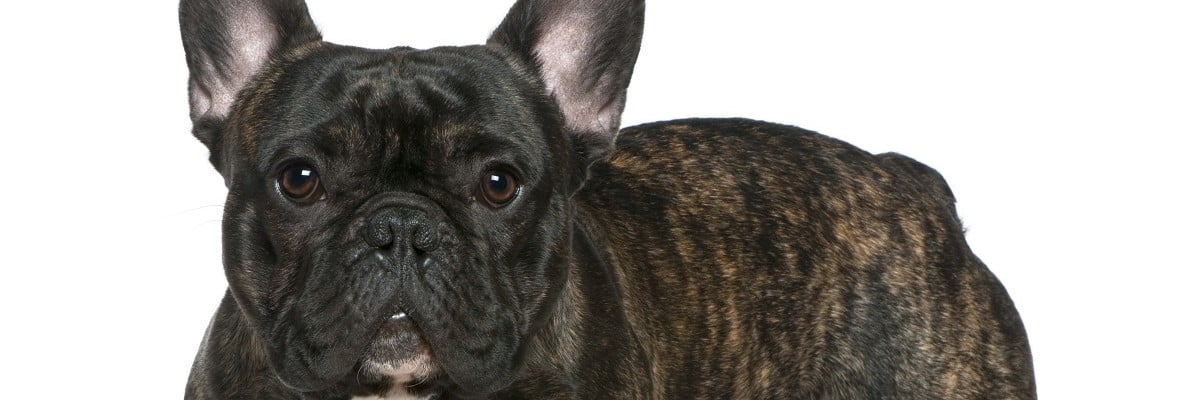French bulldogs are a beloved part of many people’s families. After all, what’s not to love about those big eyes and almost comically large ears? Who wouldn’t love cuddling up to an adorable Frenchie face after a long day at work? You might not know what to expect if you’ve never purchased a puppy. One thing that many breeders ask during the purchase process is which color someone may want. As one of the oldest colors, many people associate the breed with a brindle fur pattern. However, brindle markings can be somewhat rare, requiring both parents to carry the recessive brindle gene.
How Much is a Brindle French Bulldog?
French bulldogs are already quite expensive– as a popular purebred dog, you are likely to spend a hefty amount to get one from a trustworthy breeder. On average, Frenchies cost $2,200, while brindles tend to cost a bit more. Well-bred brindles may run between $5,000 and $9000.
| On average, Frenchies cost $2,200, while brindles tend to cost a bit more. Well-bred brindles may run between $5,000 and $9000. |
Due to the additional risks and costs of breeding, Frenchie puppies tend to be more expensive than many other breeds that can birth naturally. The reason for this price is the difficulty with breeding. Because of their heads and bodies’ size and shape, they cannot give birth naturally, and breeders must plan on the added cost of paying for a C-section surgery.

Do Brindle French Bulldogs Have Health Issues?
Frenchies are prone to health issues, regardless of coloration. While brindle pups aren’t necessarily more prone to most illnesses or health issues than other colors, you can still expect to see some common health issues, especially from a backyard breeder.
Brachycephalic Obstructive Airway Syndrome
| Several brachycephalic, or short-snouted, dogs suffer from what is known as brachycephalic obstructive airway syndrome (BOAS). The shape of the snout of the dog causes this. Frenchies have short noses and normal tissue or skin that many dogs with larger noses have. Because of this, they get that stereotypical folded look on the face that so many people love. However, that same folding and excessive tissue level may also form inside the body. They typically have too long of a tongue for the shortened shape of their heads, which further blocks airways. |
Cherry Eye
| Cherry eye is also common in Frenchies. It is caused by the nictating membrane, or the third eyelid, becoming prolapsed. The nictating membrane is next to the eye, which contains the gland responsible for tears’ production. It swells with a cherry eye, then flips over and protrudes to create the telltale presentation. If you notice a pink bulge in the eye or abnormal itching, rubbing, or pawing at the eye, your Frenchie may need to get checked out at the vet and may even need surgery to repair it. |
Skin Fold Dermatitis
| All of those adorable flaps and folds of skin can look adorable, but they may also harbor an overgrowth of bacteria or yeast that can cause irritating infections. Because skin folds are warm and may maintain moisture, they create the perfect environment for infection. That infection can be painful for your pup, and you must keep your dog’s folds clean and dry to prevent them. Typically, the first signs of skin fold dermatitis are a noticeable smell and reddening of the skin within the skin folds that have been infected. |
Color Dilution Alopecia
| Some brindle dogs can develop color dilution alopecia (CDA). To inherit CDA, the Frenchie must have inherited a specific dilute gene and then developed the condition separately. Not all dogs with dilute coats will develop CDA, but they may be at risk. Typically, these dogs appear completely normal at birth, but they start to lose patches of fur and sometimes itchy, flaky skin by around six years of age. |
Little French Dog is a participant in the Amazon Services LLC Associates Program, an affiliate advertising program designed to provide a means for sites to earn advertising fees by advertising and linking to Amazon.com.
Are Brindle French Bulldogs an Officially Recognized Color?
If you want to show your Frenchie that you plan to purchase, you might wonder if you can still get a brindle dog. The good news is that many kennel clubs recognize the brindle pattern. The American Kennel Club, for example, recognizes brindle coat patterns so long as the base of the pup is white, cream, or fawn.
Other colors, such as blue, black, tan, or chocolate, are disqualifiable, so keep that in mind when choosing the kind of brindle coat you prefer. Of course, just because some brindle patterns are disqualified for a show doesn’t mean that the dogs themselves are flawed or no good as a pet!

What is Brindle On a French Bulldog?
Brindle is the striping pattern that creates the look. These dogs appear almost mottled with the various dark and light stripes across their bodies. Typically, this involves a darker coat color with a pattern of lighter mottling across the body. This gene is recessive and requires that recessive genes from both parents inherit the brindle look.
Types of Brindle Coats on a French Bulldog
If you’re interested in brindle Frenchies, remember that they come in a wide range of presentations. You could see all sorts of different looks while searching for your brindle pal, and that’s okay! That’s part of the appeal of this particular variant– they look so unique!
| Blue Brindle: Blue brindles are not officially recognized due to the dilute blue color. However, they still make stunning dogs. These dogs have a blueish-grey coat with brindle striping. | Chocolate brindle: Chocolate brindles have a brownish coat with milky dappling across their bodies. Like blue brindles, technically, chocolate coloration disqualifies these pups from being AKC-recognized and approved, but they still make great pals. |
| Pied Brindle: Pied brindles have a white or eggshell-colored coat while then having splotches of darker colors. Typically, they have patches on both eyes and ears and patches along the back and hindquarters. Those patches may be typically brindled as well. | Reverse Brindle: The reverse brindle Frenchie has a light-colored coat, usually white, cream, or eggshell, with darker mottling. Though the coat’s base is lighter, the darker patches are so prominent that they appear to be darker than they are. This is a rare presentation. |
| Seal Brindle: Seal brindle Frenchies tend to present with dark coats mixed with light hair. The light hairs are usually barely visible, and these brindle dogs may be mistaken for solid black. | Tiger Brindle: Tiger brindles have darker coats with thick strips of lighter fur. The heavy presence of whiteness can help create a tiger-like effect, hence the name. |

How Can I Find a Brindle French Bulldog?
If you’re wondering how to find a brindle Frenchie, you might be tempted to go straight to online classified ads or sites that help connect people with puppy sellers, but these are typically not recommended. If you want to get a well-bred healthy pup, you should find a reputable source for your pup.
Responsibly bred Frenchies cost significantly more than puppy mills or backyard breeder pups. Still, they are also healthier, and the breeder focuses more on creating show-quality pups than just making a quick buck off breeding. Reputable breeders typically want to better the breed and are careful about temperament and health while creating restrictions, such as a contractual obligation to neuter your pet.
Search for French bulldog breeders in your area, or search for Frenchie rescues. These are some of the most responsible ways to get a Frenchie in your life. And be ready to wait– many of these breeders have a waiting list that may take a few years, but getting a healthy, well-bred pup will be worth it.
What Should I Ask the Breeder?
Before you agree to buy a pup, there are questions you should always stop to ask your breeder to help yourself get that peace of mind that you are getting the healthiest dog possible. If your breeder avoids these questions or doesn’t want to answer them, they likely are not very reputable or are trying to hide something. This is a huge red flag to avoid purchasing from this person.
| Ask to meet the parents. | Ask about health tests performed on the parents |
| Ask about experience with breeding Frenchies | Ask about the socialization of puppies before coming home |
| Ask about a health guarantee and contract | Ask about a health guarantee and contract |
| Ask how the breeder screens people before agreeing to sell puppies. |
Conclusion
If you want a Frenchie in your life, you are making a great choice! But you also have to be mindful of your pup’s health. Remember that you need to screen your breeders well and know exactly what you want before you start looking for a pup. Especially if you want a brindle pup, you want to make sure you do your due diligence before agreeing to buy from a breeder.
https://littlefrenchdog.com/blue-french-bulldog-whats-the-facts/

